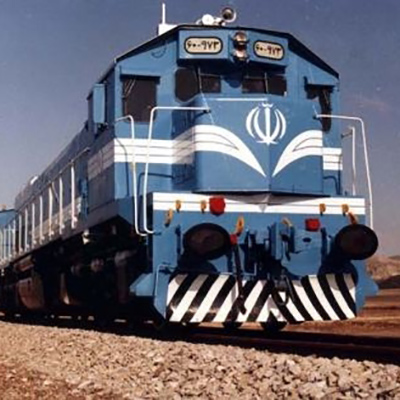Groups, Institutions, Organiza
The National Railway Organization of Iran
Written by: Mohsen Shirmuhammad
Translated by: Hadi Qorbanyar
23 Views
During the Iran–Iraq War, the National Railway Organization of Iran played a crucial role in transporting troops and providing logistical support.
The railway was first developed in 1814, when James Stephenson built the first steam locomotive in England.[1] The history of rail transport in Iran began in 1888, with the construction of a short line connecting Tehran to the shrine of Abd al-Azim (as) in Rey.[2] Later, in 1927, work began on the Trans-Iranian Railway, linking the Bandar Shahpour (now Imam Khomeini (ra)) to Bandar Shah (now Torkaman), which was completed in 1938.[3] This railway line played a key role during World War II, carrying about 4,380,440 tons of military supplies and equipment as part of the Allied effort to support the Soviet Union.[4]
When the Iran–Iraq War broke out, the National Railway Organization of Iran allocated much of its capacity to transporting military equipment and troops from the Army, the Islamic Revolutionary Guard Corps (IRGC), and the Basij. This was done under highly dangerous conditions, as railway stations along the southern, northwestern, and even central lines were constantly exposed to enemy air raids and artillery fire. Trains carrying soldiers or military cargo often traveled at night, without lights, and in the shortest possible time to avoid detection and targeting. Many strategic bridges in the Lorestan region, along with unloading stations, were repeatedly bombed and severely damaged.
Despite these challenges, passenger trains that normally had a capacity of about 600 people often carried more than 1,400 volunteers heading to the frontline.[5] In six-person compartments, eight or nine people would squeeze together, and when space ran out, some would sit or sleep in the corridors.[6]
At the request of the Army Headquarters, special “war trains” were put into service to transport all kinds of light and heavy ammunition, including tanks, to the battlefronts.[7]
The National Railway also played a humanitarian role by evacuating the wounded. It allocated five special hospital trains, each equipped with an operating room and 200 hospital beds. During major operations, three to four trains, each carrying between 300 and 400 injured soldiers, ran daily to provide medical evacuation and logistical support.[8]
The National Railway Organization of Iran also took part in road construction projects along the frontlines. Its engineering teams built more than 35 kilometers of new roads in war zones and transported hundreds of tons of sand and gravel — sometimes as much as 160 to 170 train wagons a day — to the battlefronts for use in roadbuilding and trench construction.[9]
The National Railway further contributed to the construction of defensive positions[10] by sending nearly four million wooden railroad sleepers to be used in building bunkers and shelters for the troops. Other forms of support included providing storage hangars to the IRGC’s Self-Sufficiency Unit, building portable bridges, and delivering heavy construction machinery.[11]
In the last two years of the war, as air raids and missile attacks on cities intensified, the need for shelters became urgent. At the time, the National Railway Organization of Iran made several reinforced buildings available for public protection — including the Tehran Central Station and underground levels of other railway structures — saving hundreds of lives during bombing and missile strikes. In addition, it constructed a number of new shelters, such as those built in schools across Tehran,[12] totaling 38 shelters overall.[13]
Another major contribution was the evacuation and relocation of families displaced by the war to safer areas. The National Railway’s recreational complex in Khazarabad (near Sari) was also used for housing war refugees from the early days of the conflict and continued to serve them for several years after the war ended.[14]
Throughout the war, Iraqi forces repeatedly targeted Iran’s railway network with missiles and air strikes. The heaviest damage occurred in the Lorestan region (centered in Andimeshk) and in southern Iran (centered in Ahvaz and Khorramshahr). One of the most serious attacks came in January 1987, when Iraqi aircraft bombed the Tale-Zang Bridge — located between Doroud and Andimeshk — severing the railway line.[15] Nevertheless, the National Railway personnel managed to resume service within a week by setting up a temporary station north of the bridge and building a makeshift footbridge for passengers and troops.[16] In another incident on November 25, 1986, Iraqi aircraft bombarded Dezful, as well as Andimeshk and its railway station.[17] The attack, carried out by 54 fighter jets over the course of an hour and forty-five minutes, caused heavy damage to the Andimeshk station and its surrounding facilities.[18]
Throughout the Iran–Iraq War, a total of 120 structures and technical facilities in the Lorestan-to-south railway zones sustained severe damage, while about 650 administrative and residential buildings were either completely destroyed or heavily affected.[19]
Another key contribution of the National Railway during the war was dispatching engineering and technical teams to repair and rebuild damaged bridges, facilities, and railway lines. One remarkable example was the reconstruction of the 120-kilometer Ahvaz–Khorramshahr railway line, which was completed in just 100 days.[20]
The Chotour Railway Bridge — located near the border between West Azerbaijan Province and Turkey — played a vital role in importing and exporting goods during the war. Destroying this strategic bridge, which connected Iran to Europe, was one of Iraq’s key objectives.[21] The Iraqi Air Force bombed the bridge’s concrete pillars six times:[22] March 13, 1986; May 7, 1986; May 17, 1986; May 26, 1986; January 18, 1987; and February 26, 1988.[23]
In response, the National Railway personnel constructed a temporary road beneath the bridge, using heavy Titan trucks to haul train wagons between the two sides. This allowed railway traffic between Iran and Turkey to resume despite the repeated bombings.[24]
The National Railway Organization of Iran also contributed to transferring prisoners of war to Tehran under the protection of the armed forces.[25]
Over the eight years of the war, 7,747,660 military personnel — from the Army, the IRGC, and the Basij — along with 37,471,036 tons of military equipment, were transferred by trains.[26] In addition, 12,000 National Railway personnel and employees voluntarily served at the war, of whom 247 were martyred, 5 went missing in action, 290 were captured, and 1,241 were injured.[27]
After the war, in light of the urgent need to rebuild war-damaged regions, the National Railway Support Headquarters established a new Reconstruction and Engineering Department in 1988. This unit oversaw and supported all reconstruction activities until 1994. Its mission later expanded beyond wartime recovery to include national reconstruction efforts, such as rebuilding after the devastating 1990 Rudbar earthquake.[28]
Iran’s railway network continued to expand after the war. Major projects included the 633-kilometer Bafq–Bandar Abbas line (completed in 1994), the 926-kilometer double-track Tehran–Garmsar–Mashhad line (completed in 2001), and the 800-kilometer eastern transit corridor linking Bandar Abbas to northeastern Iran (completed in 2005).[29]
Today, key railway projects under construction include the Hamadan–Sanandaj line, which will connect Kurdistan Province to the national railway network; the Mianeh–Ardabil line; and the Rasht–Caspian line.[30]
[1] Mokalemi, Muhammad-Kazem, Tarikh-e Jame-e Rah-Ahan (Comprehensive History of the Railway), Tehran, Edare-ye Kol-e Ertebatat Omumi-ye Rah-Ahan-e Jomhuri-ye Eslami-ye Iran, Vol. 1, 1377, p. 109.
[2] Mokalemi, Muhammad-Kazem, Tarikh-e Jame-e Rah-Ahan (Comprehensive History of the Railway), Tehran, Edare-ye Kol-e Ertebatat Omumi-ye Rah-Ahan-e Jomhuri-ye Eslami-ye Iran, Vol. 2, 1379, p. 267.
[3] Davoudi, Arash, Hamas-e Javid: Naqsh-e Rah-Ahan dar Hasht Sal Defa Muqaddas (The Eternal Epic: The Role of Railway in the Eight Years of the Sacred Defense), Tehran, Edare-ye Kol-e Ertebatat Omumi-ye Rah-Ahan-e Jomhuri-ye Eslami-ye Iran, 1395, Pp. 27, 30.
[4] Ibid., Pp. 32–34.
[5] Ibid., p. 67.
[6] Naqsh-e Rah-Ahani-ha dar Defa Muqaddas (The Role of the Railway Personnel in the Sacred Defense), Websait-e Mashhad Chehr, 26 May 2023, www.mashhadchehreh.shahraranews.ir/fa/news/5057
[7] Davoudi, Arash, Ibid., p. 67.
[8] Ibid., p. 68.
[9] Ibid., p. 66.
[10] Esmailzadeh, Samad, va Gholamhussain Amirbeigi, Logistik (Logistics), Tehran, Iran Sabz, 1397, p. 130.
[11] Davoudi, Arash, Ibid., p. 66.
[12] Ibid., p. 66.
[13] Ibid., p. 67.
[14] Ibid., p. 68.
[15] Ibid., p. 70.
[16] Ibid., p. 71.
[17] Moamma, Muhammad, Ghoresh-e Raad: Zendeginameh-ye Sartip Khalaban Abdolhamid Najafi (The Thunder’s Roar: Biography of Brigadier Pilot Abdolhamid Najafi), Tehran, Emad-e Farda, 1394, p. 251.
[18] Davoudi, Arash, Ibid., p. 70.
[19] Ibid., p. 70.
[20] Ibid., p. 71.
[21] Ibid., p. 73.
[22] Gholami, Baratali, Padafand-e Havaei, Ruzshomar-e Defa Muqaddas (Air Defense, Sacred Defense Chronology), Vol. 2, Tehran, Entesharat-e Iran Sabz, 1399, Pp. 447, 460, 463, 464, 537, 650.
[23] Davoudi, Arash, Ibid., p. 244.
[24] Ibid., Pp. 74, 244–247.
[25] Ibid., p. 69.
[26] Ibid., p. 67.
[27] Ibid., p. 69.
[28] Ibid., p. 263.
[29] Tarikhche-ye Rah-Ahan-e Iran (History of Iran Railway), Tinn News: Shabake-ye Khabari-e Sanat-e Hamlo Naql, 30 Aban 1401, www.tinn.ir/39429
[30] Roshd-e Se Barabari-ye Khatt-ha-ye Reili-ye Keshvar baad az Enqelab (Threefold Growth of the Country’s Railway Lines after the Revolution), Websait-e Tahlil Bazaar, 18 Bahman 1400, www.tahlilbazaar.com/news/134093





